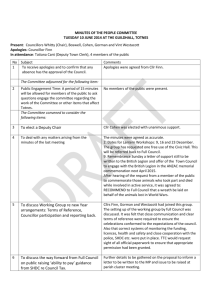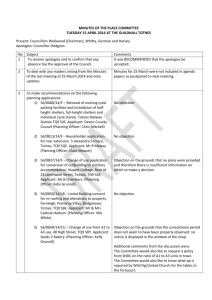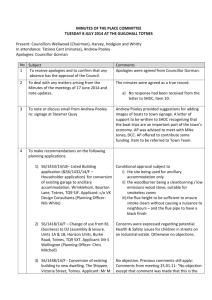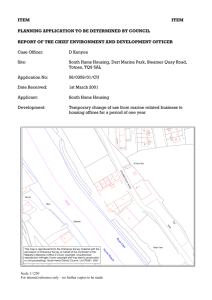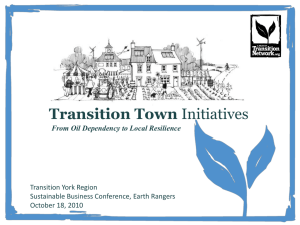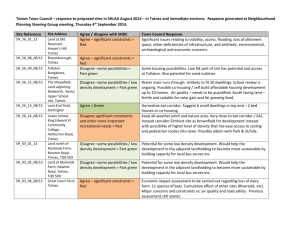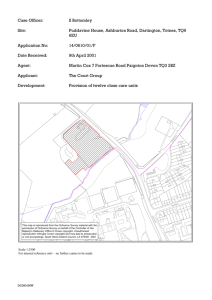FULL REPORT For - Baltic Wharf Boatyard
advertisement
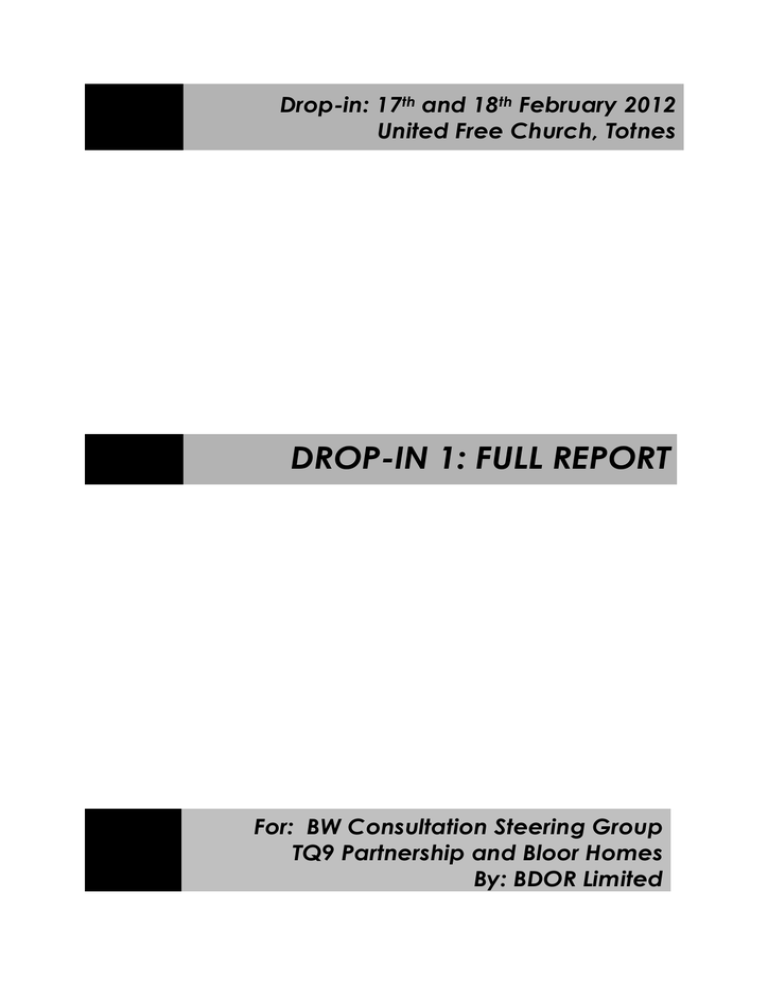
Drop-in: 17th and 18th February 2012 United Free Church, Totnes DROP-IN 1: FULL REPORT For: BW Consultation Steering Group TQ9 Partnership and Bloor Homes By: BDOR Limited INTRODUCTION This is a fairly ‘raw’, background, working document, produced as a full record of all the results from the drop-in event held in the United Free Church on 17th and 18th February 2012. It is being placed on the project website to make it available to anybody who wishes to see it. The contents of this report are largely verbatim material, with some minimal regrouping of points and analysis as appropriate. There are several sections as follows, each explained more fully at its start: Promotion, Format and Attendees Results from the Town and Landscape Character panels Results from the Issues/Ideas Sheets Results from the Key Points sheets Notes on workshops Miscellaneous Comments Key results have been pulled together into a Summary Report (attached as an AppendiX), included here in part because it offers an overall reflection on what took place and what was said. Please refer to that for any overall comments. The Summary been sent to all who signed in, to some who made contact after but were unable to attend and to other stakeholders on the latest database. It will also be placed on the project website. PROMOTION, FORMAT AND ATTENDEES This event was promoted in the following ways: A full page advertisement in the Directory that is delivered to all households in Totnes. AdvertIsements in the Totnes Times and Totnes News A Press Release was sent to local papers and to local radio. This resulted in some good coverage both in advance of the event, during it and afterwards. All key stakeholders were informed about the event. Promotion during the event was via a billboard at the front of the venue and almost constant staffing of this by a team member, encouraging people to come in. The basic format was as follows: The event was located at the United Free Church, Fore Street, Totnes. On Friday 17th the event was based in a room at the back, accessed via a narrow path. However, with someone stationed and directing at the street front, it is doubtful if this slightly awkward access actually put anybody off. By contrast, the open front doors on Saturday provided a very welcoming approach (supported again by the person standing at the front). The back room was perfectly adequate, the main room for the Saturday was excellent. People were able to call in at any time between 11.00 and 19.00 on Friday 17th February and 10.00 and 18.00 on Saturday 18th. The weather was fine on Friday but rain on Saturday no doubt affected turnout. On arrival people were asked to sign in. If this was queried they were told that this was to be able to (a) send them a report of the event and (b) notify them personally of future events. If two or more people were together they were asked to give all (adult) details. We suspect that not all did so. After signing in they (more usually a team member) placed a dot on a map to show where they live – not completely accurately but to show a general pattern. People living ’off’ the map placed the dot in the relevant direction. Almost all people were given a verbal briefing by a team member. Having been welcomed, people were invited to look at what was on the exhibition boards, take a pen and comment. They were invited to start in any order they wished but encouraged to leave the Key Points sheets till last. There were also Comments Books readily available for anybody wishing to add longer comments or preferring to comment more privately. At all times there was (at least) one landowner representative, one developer representative, two from the design team and two from BDOR present to help. Some members of the project Consultation Steering Group also assisted informally for a couple of hours at a time. In terms of attendees: The sign-in sheets record 264 names, slightly more attended on Saturday than on Friday. Some couples signed in for two but some people will have slipped through, as may have some individuals at peak times. The likely total number was therefore close to 300. The maps of sign-in dots, with similar patterns for Friday and Saturday, show that the majority of people came from Totnes, evenly split in general between the main town and Bridgetown. The evenness of the split was slightly distorted by the large number of people who lived right next door to or very near the site. A few people came from further afield, eg. Dartington, Ashprington or Torquay, a few were from further away, usually coming with the local friends they were visiting. It was clear – some told us this – that some who came early on came back to give more time to the tasks and/or went back to tell friends and neighbours who then came along. The remarkable thing was how long people stayed; an estimate would suggest an average of well over 30 minutes. Very few people came and went in just a few minutes, usually if they had arrived without being aware the event was on and while they were in the middle of shopping (and some came back). It was impossible to check but very few people did not make at least some comment or put up at least a few ticks on the sheets. Without any real ‘policing’ it is impossible to say whether some people put lots of ticks in boxes or repeated their comments on every sheet – but this seemed to be very rare. There were one or two occasions when people came in solely to protest about the very fact of the development, although even some of these went on to add comments. A good number of people commented positively (some extremely positively) on the fact that this type of consultation was being held at this time. A few made the comment that they hoped other developers in Totnes would now follow suit. TOWN AND LANDSCAPE CHARACTER Members of the Stride Treglown design team brought along a number of sketches, photos, drawings etc. that they had prepared to highlight possible key points about the distinctive nature of the architectural character of Totnes as a town and about the character of the landscape on and around the site. Similar material had been used at the stakeholder workshop a week or so before and it was slightly updated and edited from that event for the drop-in. This material was on display and people were invited to annotate drawings, add comments etc. The aim was to validate and extend, especially with real local detail, the analysis done to date. The comments below would of course mean more to anyone not there if we were able to include the very large number of relevant drawings and photographs, but that has not proved possible. Use materials that need low maintenance - Southgate? 'Maritime and industrial styles’ as in drawing above, would be very much in sympathy with the riverscape. So long as not phoney practice! Agree - medieval character coming through. Nice windows. Slightly chaotic in a good way (to use your own words) is ideal. Like a village perhaps, shapes/cladding/roof finishes irregular. Very much agree with point 1 above. The whole development will be very visible from the river. Are there any maritime features that can be retained? "Totnes is one of the most rewarding small towns in England, appealing in the visual variety of the small buildings close-packed within the framework of its medieval street plan, intriguing in the exceptional quantity of wealthy merchants' houses.....": Devon The Buildings of England, 2nd Edition, Bridget Cherry and Nikolaus Pevsner. "Totnes is one of the most distinctive of our small towns and the preservation of that individuality is vital". Alec Clifton-Taylor's Totnes 1978. Modern, well designed building to complement what we have but not trying to copy it i.e. not 'mock Tudor'. (Not pastiche!) Must complement the immediate buildings, the gateway to the development, St Peter's Quay and Terrace and Steam Packet Inn. Use the existing diversity of house/building styles already in the town. OK in principle, but consider traffic, enough traffic jams/congestion in summer already. Time: the worst heavy plant traffic around summer congestion or the town will grind to a halt. Maritime industrial architecture and colour and texture and planting that 'matures well'! ISSUES AND IDEAS SHEETS Each of the ‘Issue/Ideas Sheets’ was headed with a specific topic – eg. Layout. At the top of each sheet were listed the ideas that had emerged from the project team’s work and especially from participants at the workshop held a week or so before – ie. from local people not just ‘outsiders’. Attendees were invited to tick if they agreed with a listed item, place a cross if they disagreed, to elaborate any ideas if they wished to and/or to add ideas that they felt had been missed (most of the latter on blank sheets provided. There was also a sheet for ‘Anything Else, any additional points not picked up by the prepared topics. The results follow overleaf. In each case the original prompting items are noted in bold (and italics). The numbers of ticks and crosses are shown. Elaborations or further ideas are shown in plain text (not bold). Note that ticks against added points are not a reliable indicator because some points were only added late during the event so (unlike our prepared comments) not everybody was able to see them. Also note that some writing was difficult to decipher and some place/road names may well be wrong. LANDSCAPE AND ECOLOGY 1. Retain all good condition trees and hedgerows. 108 2. Especially to protect bridleways etc. across the top of the site. 94 3. Create more/better footpaths into and across the space. 71 1 4. Create more/better cycle paths into and across the space. 41 6 5. Community ’right to roam’ 33 21 ?6 6. Keep it simple and green with no structures. 44 2 ?1 7. Include sculpture/art to complement green spaces. 34 16 8. Include some imaginative play equipment for children. 47 8 ?1 9. Include some sort of shelter. 8 8 ?9 10. Use part for food production for residents. 44 16 11. Space for food production for the wider community (allotments). 45 20 12. Create part as an orchard. 73 6 13. Some parts or some uses to be community managed. 17 14 ?1 14. No intrusive lighting, minimise light pollution. 98 15. Initiatives to enhance biodiversity. 58 3 16. Natural, environmentally friendly flood defences. 73 17. Opportunities for recreation/sport activities for the community/young people. 25 11 Leave it alone. 2 1 Don’t overdevelop land around in terms of footpaths access etc. Lets have a bit of wildness and nature not completely controlled for human need. 3 Allotments, fruit trees as landscaping 2, raspberry in hedges 1, wild strawberries etc, traditional old Devon varieties. More information needed. Don’t overdo it! 3 Talk to the Sharpham Trust/estate on working together. 16 Food production – priority for green slope. 2 Recreation – need for adolescents – natural landscape, climbing, challenge. 7 1 No Totnes playparks cater for adolescents except skatepark. 1 1 Wildlife friendly planting (Sarah Raven programme at Harrogate). 12 Enough space between houses – not too cramped/overdeveloped. 16 Ensure plentiful views of the river are maintained. 15 Drainage/flooding – history 2. Flooding should not make the flooding worse for nearby residents: St. Peter’s quay, New Walk, Wellends etc. Remember this will be first view of Totnes from river – visitors by boat. 2 One acre of growing space seems insufficient for the whole site, or even for all of phase 1. Need further growing spaces for site as essential and potentially increasing need. Also, the arrangement for cohousing to manage this one acre for all is not the best arrangement possible. 1 Support need for maximum growing space/allotments. Draw on the rest of Totnes for ideas and materials. Devon hedges, fruit trees/hazels as part of landscaping. Let a bit of wildness in too. Local species but don’t spend too much on it. 47 Performance space on both Plaza and Green areas. 3 Sloping hillside provide a natural amphitheatre which with design could be made dual use. 2 3 Green space not over formalised or landscaped. 11 Leave as naturalistic as possible. 12 Maintain natural beauty – keeping green hill/slope backdrop. 6 Leave green fields! 6 Pollinating plants for bees and other insects. 9 Green growing space – Yes! 6 Keep green space to just sit and enjoy the river – don’t try to utilise every bit of space! 10 Existing hedgerow along St. Peter’s Quay is full of birdsong – wonderful! More cycle lanes. 2 Better river access – swim platform. 7 Design community veg planters so they are raised 3 foot, not too small, with water butts near for water. 2 Need for allotments. 8 Is one acre of growing space best used for community growing or yeoman (allotments) tenancy? Or 50:50 and trial both? Be very careful about tree removal so that general character of St. Peter’s Quay is not urbanised. Food growing: at least half green slope for allotment. LAYOUT ISSUES/IDEAS 1. Minimal interruption of views to the green slope from outside the site. 71 2. Minimal interruption of views from the green slope to outside the site. 57 3. Sensitivity to key views to the site/slope from other side of river especially. 50 4. Limit on building heights. 87 5. Include varied heights. 50 2 6. Include varied building forms. 58 1 7. Sensitivity to views from houses above the site. 52 See no7. Also sensitivity towards houses below the site, eg. St. Peters Quay and Terrace – Phase 1 site is roughly 1.5 – 2 streets above at St. Peter’s Quay and so new development could be overbearing. 8. And from the bridlepath above the site. 47 9. Include incidental areas of green space. 52 1 10. Work with the existing topography. 53 11. Maximise orientation for solar gain. 48 12. Draw on the ‘scale and grain’ of the local landscape and townscape. 32 1 13. Respond to Totnes context and history but be of the 21st century. 44 2 13. Suggest visit to Poundbury! (yukky horrid place) 1 14. Not a suburb but integrated into the town. 52 14. Integrated into town yet with distinct identity.15. Design in pedestrian priority. 48 16. Maximise views from houses/flats. 25 See 16. Yes but not at the loss of significant nos, of trees along St. Peter’s Quay that would urbanise the wharf/quayside character. 17. Include public art. 20 22 Employ local business/ design firms/art/playpark developments. 2 Use materials that reflect the origins of the site and the materials used in the town. Please. Open space/adequate children’s play spaces essential. 6 Just make sure it doesn’t look like a dog’s breakfast. This is the first thing visitors (by boat) will see of the town – so make it look really, really good! 7 1 Let’s have contemporary (glass/natural wood/foliage). Too much emphasis on fitting in with Totnes’s original architects. Needs to be stand out beautiful piece of architecture. These styles can live side by side. 1 Disagree to above – using traditional materials reflected in town is a good way to link the old and the new as well as being more beautiful, using local materials/reclaimed even better. Zinc is hideous 5 but zinc doesn’t necessarily mean modern. 2 1 Styles can live side by side but remember this is Totnes not Paignton or anywhere else! Hear hear. 7 Very important to use a wide range of materials that sit well together – even different types of wood grains etc. Can easily incorporate modern steel/glass etc – a happy mix. 1 2 Don’t make it resemble Canary Wharf when looked at from a boat coming upriver from Dartmouth! 5 It is a magic access point into the town – RIVER – its layout should reflect this and be an introduction and encouragement for people to visit the town. 5 Keep traditional, look as at Dartmouth (the marina). Do not want scruffy houses in 20 yrs time and an eyesore next to listed buildings (the entrance to the development) this should visually flow. No hippy style houses please! 5 4 Not more houses in the style of Leechwell development. These won design awards (?!!) yet are thought of as ugly by lots of people and are in no way sympathetic to a mediaeval town. Modern/glass/wood is very trendy but can easily look tacky, eg. concrete painted can peel easily and look cheap. The more expensive and quality materials are what we need – these homes need to look good for years to come. 3 Ensure open space in scheme not remote. 2 As few little roads as possible but with enough parking. 5 3 Public transport turning point. 7 3 Electric charging points (cars.) 7 Structural landscaping. 6 Allow for future development post 2026. 10 Keep landscape informal and natural, integral to forest and fields. 12 Avoid over development, e.g. as Pollaton. 4 Limit car parking spaces in design for whole development, too many houses already in area. 2 Supply adequate parking for every house and allow for visitor parking. 3 2 Allotment space. 4 An area like a plaza where people/kids can meet/chat etc. Maybe music. 1 No through road to rest of site through middle of phase 1. DESIGN ISSUES/IDEAS 1. Reflect and extend the existing character of Totnes and the wider landscape. 47 2 2. But also make it clearly of the 21st century. 24 9 3. Integrate into the town/riverside. 44 4. Tenure-blind integrated housing. ? 5. Active ground floor uses where possible (ie. not lots of blank garage doors). 43 6. Use roof spaces (if flat). 32 6 7. Balconies provided for non-ground floor homes. 46 1 8. Careful with colour/tone against the green slope background. 48 9. Aim for flexible room layouts (especially ability to work from home). 40 10. Include cycle storage. 40 11. Appropriate levels and type of parking provision (ie. not too much – to reduce car use, not too little – to avoid street parking). 45 1 12. No public parking on site. 35 2 13. Ground floor units to have gardens. 44 1 14. Maximise key views from within the public areas. 28 1 15. Create flexible and multi-functional external spaces, 20 1 16. Some sort of ground floor garden for any on upper floors. 28 1 17. Easily legible design, minimal street signage. 31 18. Ensure ‘Considerate Contractor’ protocol during construction. 43 The abode may be better than the plans to Vire island and then to steamer quay. Ensure that once built that people don’t have scope to build extensions etc. 5 Make roads wider, room for a bus to pass! 1 Add a footbridge over Dart at town end of site. 1 How about something really new like the modules (in Holland and the US) which are self contained and can be stacked and easily moved, so the co-housing could be extended or opened out when required – make it cutting-edge as an example of a “visitors” mecca. 3 Pay regard to existing Totnes. We are not aiming for Totnes and Baltic wharf but a design which respects the character of the present historical town and riverside buildings. Entrance by river is the Gateway to the South Hams. Natural rounded build shapes that feel good to live in and echo the organic curves of surrounding hills and landscape views (opposite side of the river). Think 10/20/50 years into the future. We will probably need this as port space again; can such flexibility be in the design? Quality of the public realm design – use little signage – design of space informs and fosters its designated use. Lead urban landscape artist at design stages. Please do not try and reproduce architecture - be bold Timeless is good. (see below) 1 Make a statement. 2 Eco design sympathetic people orientated. 2 In scale with small town vernacular. 1 Lots of stone and slate. Natural colours. Timeless. 6 Moorings for historic boats (residential?.) 2 Heights of projected buildings are crucial to all buildings – stay with present ‘Steam Packet’ lines even at back of site. 3 The river with the boat yard and masts is a real ’tourist’ view for Totness – it is a key view looking down the river from the Plains beyond. Lost it at your peril. 3 Green roofs – sedum. 5 Wide roads to reduce parking on pavement. Too many new developments have too narrow roads. Gardens for those that want to look after them. 2 Easy access to refuse bins (roadside) for binmen SHDC. Need visitor parking but not unrestricted public parking. 2 Interesting and quality – something that looks great. Use glass/steel/wood and foliage. 5 Reclaimed. Draw on the working history of the site: colours/materials. The river: colours, the landscape: colours and materials. Please don’t’ do something stand out. 4 All of the photos of the town show no two houses the same – this is what Totnes is about – all slightly different. 10 Totnes viewed from most vantage points is a town of roofs. The new development will be very visible from above and along the river. The new roofscape should fit in, be symmetrical – no zinc, copper, lead, just sympathy. 4 Future-proof houses so that growing families can remain in property i.e. by converting roof. 2 Stained not painted wood where necessary and subtle colour. Respect Totnes and the river but don’t be frightened to experiment. Good quality contemporary design that works with ‘old’ Totnes. 1 No bright blue (like the warehouses across the river), more subtle colours that blend in. 5 ACCESS AND MOVEMENT ISSUES/IDEAS 1. Having one vehicle entrance point (by the Steam Packet) demands real care. 81 2. Pay careful attention to safety, speed etc. 70 3. Reduce dependency on cars. 55 4. Traffic calming in the approach to the site. 58 3 5. Avoid any short cuts or rat-running in approaches to the site. 77 6. Pedestrian priority across all of the site, aim for 20mph maximum. 64 7. Controls on access times for HGVs. 71 1 8. Introduce noise reduction measures. 48 9. Full disability access throughout. 55 10. Continuous public path along the river frontage. 86 11. Clear cycle routes in and around. 50 2 12. A communal, secure place to leave bikes overnight. 54 13. Good street lighting but with no/minimal light pollution. 53 1 14. Provide charging points for electric cars. 40 7 15. Introduce a few more connections from existing footpaths above the site down to the river and the waterfront. 55 5 16. ‘Travel Plan’ to include regular buses, car club/sharing schemes, site wide control system, cycle facilities etc. 61 1 17. Promote and support water taxi service. 61 1 18. River passenger ferry to steamer quay car parks. 57 19. Traffic management plan for the construction period. 52 Do not allow Moat Hill and Wardland to become a rat run. 2 Need to think of possible rat run through Ashprington via Totnes, Down Hill/Maudlin Rd and back lane above Dart Villas. 3 20mph too fast, 10 mph max. 3 Need to prevent excess flow of traffic into Maudlin Road as …... 33 Plains/Bridge roundabout has traffic jam problems. Seems difficult to avoid increasing traffic jams with this development – How? Very clear and controlled management of traffic on site – ownership to ensure this can be managed and enforced on whole site. 2 Residents whose properties face directly onto New Walk 1 should be fully compensated for disturbance from construction traffic. Perhaps a council tax rebate subsidised by the developers. 4 Use of Wardland as a rat run to the new development. 5 Access for emergency services? No street lights – agree. 1 No all-night long lighting – may be low level lighting 2 and free up lighting for walkways. Careful signage, Ferry instead or car parks etc. Limit traffic. Low loaders get grounded on hump on road next to Steam Packet Inn, blocking the only entrance to the Baltic Wharf area. Special arrangements will be needed for emergency access especially for fire and ambulances to retirement homes. 3 Improve drainage on footpaths. 3 Maintain current river access and width. 7 Think ahead. Be ambitious in anti-parking, less cars and encouraging other transport. 1 Use ‘shared space’ concepts for traffic/pedestrians (be brave). 3 Don’t sterilise what was built as industrial access to river. We have been a port for 1000 yrs., property bubble in 30 yrs. History tells us what prime use will most likely be in future. Allow flexible uses and adaptation in design. Totnes Port may come again – soon! Consider rest of town. Do not use narrow and unsuitable Moat Hill for contractor’s access or allow it to become a rat run to escape junctions on to The Plains/St. Catherine’s way. No vehicular access during or after development off slip road joining Moat Hill to St. Peter’s Quay. 7 More than one access point to avoid bottleneck at entrance. No! No speed bumps please. Yes! No No No speed bumps but there are plenty of other traffic calming measures available. 2 – narrow carriageways, paving not tarmac 2, cycle/pedestrian priority clearly indicated 1, movable trees/shrubs/plants to make chicane 1, cycle/pedestrian access other side of planter. 3 Pedestrian access only should be permeable, to take bikes too. 1 If motor traffic access is via New Walk without alteration as above it will rapidly become unusable as part of NCN2. 2 Don’t have cars parked in front of each house etc – we have a communal area + make safe + accessible. Agree with comments above re. New Walk 5 1 (Totnes disabled ). Preferably not visible. Links to footpaths – Sharpham drive etc – but please don’t have tarmac 2, gravel 2 – people are able to walk on mud. Max 20mph along New Walk. 6 This is the pinch point – not easy to envisage a solution. 2 Would be helpful to view a 3D moving representation 8 of projected traffic flows at various stages of the development compared to current traffic flows at the pinch point. No vast tarmaced roads, inter space with cobbles. 1 Moat Hill one way only (downhill). 3 Car parking to be screened or hidden. 8 Cars parking to be kept away from river bank (not visible from Steamer Quay). 10 Will the residents of the new development be eligible for Zone B parking permits? If so we envisage ‘spill over parking’ in local streets. 4 2 Traffic issues in town have not been mentioned! 16 Pedestrian crossing in New Walk or the Plains. 10 Hundreds more cars in rush hours causing bottlenecks. 16 Travel plan will look at congestion issues – hopefully! And address these. 3 Access to Steam Packet already limited – do you know how many more cars from another 150 houses in Totnes streets? 2 There is not enough space for this. Dartington community development discussions have said that traffic cannot be considered as part of issue – nothing can be done. This must not happen as traffic congestion has to be resolved. More houses will only increase the problems Electric charging points for car/bike. 1 SUSTAINABILITY ISSUES AND IDEAS 1. Minimise the need for fresh water consumption. 42 2. Care with the provision and (minimal) use of water. 42 1 3. Ensure appropriate space and equipment with homes for waste collection and separation. 33 4. Ensure easily accessed and clean/tidy area for bins and recycling boxes/bags. 48 5. Build to very high insulation standards. 63 6. Maximise social housing. 45 3 Re. 6. More people interested in buying their own homes. 7. Consider orientation to maximise passive energy. 42 8. Introduce renewable energy technologies, eg. photovoltaics. 36 9. Maximise use of locally sourced materials. 60 10. Build to high eco-standards standards (Code level 4 minimum, for those who know that!). 38 11. Maximise use of local labour/companies during construction. 53 12. Minimise construction period impacts. 35 13. Tie the site into the existing green infrastructure. 40 14. Encourage ecology with planting, green roofs etc. 43 2 15. Involve the community in things such as tree planting, public art, maintenance. 30 1 16. No holiday homes. 91 17. Contribute to any extra school places needed. 35 18. Hard surfaces to be permeable. 43 Recycling rainwater etc . 2 Local people need housing especially regarding house prices in area. Keep our young families here! 7 Totnes school are already over-subscribed. I want to see a co-op structure for at least some of the development, so people on low income can have some say and ownership of the place. Either a co-op buying some houses for co-op members to live in or renting off the development. 1 I want to see building only on the brownfield site. 1 If you build on the green slope the development is as bad as the Linden Homes are proposing for the other site. 1 Only down river is south facing for solar. No second homes or holiday homes. 3 Why? Growing space – individual and shared. 3 Concentrate on insulation and air tightness to reduce heating cost for residents. 1 Incorporate lots of hedgerows rather than those awful close boarded fences. 1 Don’t forget small/individual wind energy generation. 1 Centralised biomass boiler for heating), food production – if not possible here where else locally? How much on town population is this? Can it be sustained? Rainwater harvesting. 9 Good quality easy collection of used cooking oil (housing and café) 1 for reuse to power community transport. Bob the Bus etc. 4 Code level 6 brilliant! Insulation and air tightness of buildings the most important. 1 Bob the bus – good idea. 1 Materials that are cheaply repairable in the future. Many modern buildings and materials deteriorate quicker than the older ones. Local building materials. 6 Rainwater harvesting – a good plan 3 heat transfer? Insulation important 1 But important to think about the experience of people living in the homes ie. woodburners. Living in a sealed unit would be/is depressing. No more white boxes. 3 No solar panels/wind power please. 2 3 Solar thermal and PHV sensitivity done. 2 Look at contents of Taunton Protocol www.projecttaunton.co.uk Avoid PHV solar. 1 Passive solar architectural design to each building. 1 Passive house standards 1 Code for Sustainable Homes is just Building Regulations. Code 4 eco standard is minimum, this should be higher. Design and build to allow installations to Code Level 5 as option for purchasers. 1 It is probably the coldest spot in Totnes – affordable and sustainable heating will have to be inventive 2 ….. AND WHAT HAVE WE MISSED? Balances workspace/jobs, affordable local housing and flexible community space (development on other side of the river, Dairy Crest, Dartington etc.). Please remember river users and those people of all ages who row on the Dart; powerboats/moorings. 1 No second home owners. 8 Please maximise affordable housing for local people (ie. not holiday homes) so that families can stay close in the area, thank you. 9 Minimise tarmac – variety of surface tone and texture can inform use of signage and visual texture. 1 Cycle routes- separate from roads. Give consideration to present cycle access to cycle path to Sharpham which is difficult at the moment off steep hill. Upgrade footpath at back of yard. Schooling: where are youngsters to be educated? KEVICC and all primary schools full. How about a few moorings for houseboats to add to the general feel for the river? 5 Water storage facilities – especially as there are already predictions of future shortages (rain harvesting etc.). 3 Consider a hub of co-housing communities for whole site. For instance, individual communities (like tribes) that interlink with others. A bit like interlinking yurts/communities that create an extended community family. A larger family community of smaller individual communities. Spaces like Leechwell community garden please. Use river for energy source? Not allowing any more sewage outlets, adding to the already hundred leading to the Dart. 1 Has SW Water confirmed that they have capacity for sewage treatment? 2 I see no mention of sewage disposal – it often frequently smells near location. 1 River pollution – bad now. What facilities will there be for the youth? 3 What about young people’s needs? 1 Need more off-road parking, no yellow lines. 2 I live above the site on the same side of the river and would be devastated if my view of the river were at all obscured. 5 People in retirement home to have use of allotments. Hint at a medieval style through the use of outside staircases and walkways between buildings. Provide ‘secret’ alleys and lanes that locals can use to walk from one end of the site to the other in between the buildings. 2 There are several residents at the ‘sharp end’ of St. Peter’s Quay/Steam Packet/St. Peter’s Terrace who are all below the level of Phase 1 ground level (roughly 2 storeys below). New development to the far north end of the site needs to be carefully designed to avoid appearing over-bearing, overlooking or cutting out winter daylighting due to its more elevated level, but I’m sure you will take care in this regard – I have faith in you guys! Dog bins – lots. 24 No dog bins but a dog loo, separate sand/gravel space, cleaned easily, even collected dog mess. Implement fines for dog owners who don’t use them. Plant trees but let them do their own thing – don’t overmanage, let things get muddy in the winter and dusty in the summer. 1 Texture, colour, non-uniformity, natural materials, good workmanship. Think Capability Brown not Midas Homes. 4 Mix up the living of private/shared ownership/co-housing – an integrated community. 3 A model of the site would make it easier to visualise the effects of your proposals. I’m having difficulty translating your 2D plans into 3D reality. 1 Mobility scooters: the footpath is a way of experiencing the wonderful landscape. Quite a few of your paths look like culs-de-sac. Strange things happen to noise echoing round the valley, the water reflects noise to people living higher up. 1 There must and will be major impact on traffic (Totnes is already at gridlock at some part of the day). 7 Impact of traffic flow through central Totnes. Totnes already has a traffic jam problem, 1 Private house sales – priority to local people and first home buyers. No projections of heights – keep to present lines at all points please. 2 Think the future maintenance of buildings. Will they still look good in 10 years/20 years time. 8 Allow for animation of open spaces. No render, natural materials only. I thought lime render was natural (added). 2 1 Use a palette of earth colours externally (no bright reds, blues, yellows, etc.) 15 Natural, organic contours – both buildings and land. 2 Lots of bench seats on public paths, areas. 8 Retain river views. 8 Should you/ not have given some broad thought to the next phase and how this phase will link into it. The people of Totnes need more detail of the whole. 2 Leave some fields. 9 Height restricted to no higher than adjoining Steam Packet Inn. 2 Consider one level housing. Priority housing for those without cars. 7 Use local workmen and local businesses. 7 More affordable rentals – why buy! 10 Security. 3 Boats – safe storage for canoes, dinghies with good launch areas. Canoe hire business facilities. Comments on the Principle of Development Other land available, ie. Milk Bottom site. Why spoil Totnes as a tourist area, people visiting on boats etc. 5 This will not help Totnes - wrong site. Right or appropriate development for Totnes, with other sites currently being considered? Does Totnes need another retirement village/space, abundant life project, and other provisions – risk of skewing demography of Totnes. Totnes is an historical place, beautiful in its old glory and I don’t see that it needs to be developed into modern, or anything more. People who lived here all their lives found it very much enough. 1 There is nothing lacking in Totnes – affordable homes (added). If Totnes with its treasures is not enough I guess it is people who will need to reshape the land for their own needs; change themselves rather than expect others to change and fit to them. People must become what they are seeking to see in the world. There are plans for up to 300 plus houses around Totnes and Dartington. We do not need more houses, we need creative ideas for employment opportunities – boats are a real advantage to Totnes. Not right for retirement village, detrimental to marine development, noisy for old people. Will stop any employment opportunities. Is there no consideration for new or existing businesses to thrive. Then the people who work in this town choose how it develops. 2 KEY POINTS SHEETS Following the analysis of the results of the workshop held on 10 th February, it appeared that a few key points were beginning to emerge. These were captured in 7 short statements and noted on large sheets. For each main point people were asked to tick a box to suggest the extent to which they agreed with the relevant statement. The statements and the results follow below. 1: Baltic Wharf should be a leading-edge example for Totnes (maybe for others) not only for what a good project ought to be (content, standards, style etc.) but also how it is developed (with community involvement). Definitely not agree 1 Not Agree In between Agree Agree strongly 2 7 29 76 2: Make the green slope into an open space for all, with the emphasis on keeping it green but with some opportunity for food growing, art works and children’s play. Definitely not agree 4 Not Agree In between Agree Agree strongly 4 29 36 36 3: Do all possible to limit the amount and speed of vehicular traffic, giving priority to pedestrians and allowing for good footpath/cycleway links to and from areas around. Definitely not agree 0 Not Agree In between Agree Agree strongly 0 0 36 82 4: Include a variety of building heights and forms that fit well into the hill behind and which relate to the traditional patterns of Totnes. Definitely not agree 1 Not Agree In between Agree Agree strongly 2 2 44 6 5: Design it to integrate with Totnes while being clearly of the 21st century, with careful management of parking and forms of open air space (gardens or balconies) for all. Definitely not agree 1 Not Agree In between Agree Agree strongly 1 21 40 43 6: Build to high insulation standards, include renewable energy technology, plan for good water and waste management and aim to use locally sourced materials and local labour/skills. Definitely not agree 0 Not Agree In between Agree Agree strongly 0 0 30 92 7: Ensure a strong and well-enforced regime of management for noise, nuisance etc. during all the construction period. Definitely not agree 0 Not Agree In between Agree Agree strongly 0 6 38 6 WORKSHOPS It had been hoped to run two 90 minute workshops for 12 people at each to allow people to dig deeper into some of the emerging issues and to share these in discussion with others and with team members. Promoting such events is always difficult. A sign-up sheet was laid out on the reception table and people were encouraged (only occasionally on Friday) to look at it and consider signing up. 6 signed up on Friday for the Saturday session between 11.00 and 12.30. In the end, and despite several announcements, no others signed up and only 4 eventually attended. All 4 were near neighbours to the project, as a result of which much of the format changed to accommodate their specific interests. Given that much of the discussion related to visual material that cannot be introduced here, no notes are included. The Saturday afternoon workshop had been pre-arranged for a group of up to 12 young people. Despite reassurances a few days before that they would attend, only one person turned up. We have received no explanation or apology from the others. COMMENTS BOOKS Three people made notes in the Comments Books as follows: Comment 1 How do we have an opportunity to discuss and influence future employment opportunities. Totnes does not need a retirement village on a site that has historic employment history. There is a chance to develop marine industries that will bring more visitors to Totnes while providing work for local people – who will also gain from housing from all the proposed developments in and around Totnes. We don’t need to lose the site to further housing, it is job opportunities that are needed. How do we ensure that housing development and a retirement village don’t adversely affect future employment and marine expansion? It is/should be a apriority that the boatyard remains and has a chance to develop in the future, alongside small marine employment opportunities. Too many houses change the nature of the site, resulting in caveats put on employment and industry – noise levels, dust etc. - which could have a long term detrimental effect on employment. What is the point of a vibrant and interesting town if there are no jobs! Baltic Wharf is one of the few innovative sites for marine development. Make it a feature for Totnes. Comment 2 It is the responsibility of every generation to leave behind a symbol of our way of life; make sure that Baltic Wharf fulfills this obligation. (Mercy King) Comment 3 This and other developments to raise the population of Totnes by 25% will destroy the town and is completely irresponsible and only of benefit to greedy developers and land owners. APPENDIX: SUMMARY REPORT
